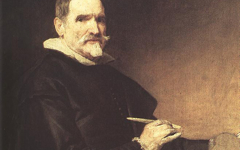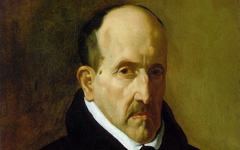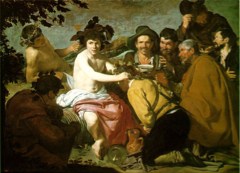Velazquez’s Count-Duke Olivares on Horseback (c.1635-6)
Even though Velazquez's portrait is recognized as a masterpiece of art, conventional explanations are political.1 The Count-Duke of Olivares was from Seville like Velazquez and was named the king's "prime minister" in 1621. He is thought to have recommended the young artist to Philip IV because Velazquez was soon named "Painter to the King". Nothing, however, is known, about the circumstances of this commission a decade later though it is sometimes thought to have been Velazquez's token of gratitude to his powerful patron. As for the format, equestrian portraits had been used to portray royal rulers before but none so dynamic as this one nor facing into the image either.2
Click next thumbnail to continue

Left: Velazquez, Count-Duke of Olivares on Horseback
Right: An artist's easel
Click image to enlarge.
Is politics all? If you know that every painter paints himself and are familiar with the techniques explained here, the whole illusion in this composition changes. Here's how. An artist's easel in Spanish is caballete derived from the Spanish for a horse, caballo, because it always has two hind legs and faces, so to speak, into the picture with the painter as its rider. It is a similar process in Italian and French.3 You can see the link between the two forms at left.
Click next thumbnail to continue
The Count-Duke is "an artist" using his long, thin baton as "a brush" to paint the scene and he looks out over his shoulder as artists often do when painting. The image at left was intended as an amusing scene on the web. It is nonetheless a remarkably accurate diagram of the image in Velazquez's mind.4 The red sash is a sign of the "honors" due to a great artist while the smoke billowing across the battlefield represents his imagination in his mind. The Count-Duke's "painting" is a scene of Velazquez's own struggle to create a masterpiece.
More Works by Velazquez
This painting of a sculptor sculpting has always confused viewers because he looks like he's drawing. Is he?

Velazquez’s Juan Martinez Montanes (1636)
Notes:
1. W. Liedtke and J. Moffitt, "Velazquez, Olivares and the Baroque Equestrian Portrait", Burlington 123, 1981, pp. 535-6
2. Velazquez (London: National Gallery) 2006, pp. 38, 180
3. In Italian an easel is cavaletto from cavallo, a horse. In French an easel is un chevalet from the French for a horse, cheval.
4. If you know the designer, please contact me so I can give full credit.
Original Publication Date on EPPH: 05 Dec 2011. | Updated: 0. © Simon Abrahams. Articles on this site are the copyright of Simon Abrahams. To use copyrighted material in print or other media for purposes beyond 'fair use', you must obtain permission from the copyright owner. Websites may link to this page without permission (please do) but may not reproduce the material on their own site without crediting Simon Abrahams and EPPH.




